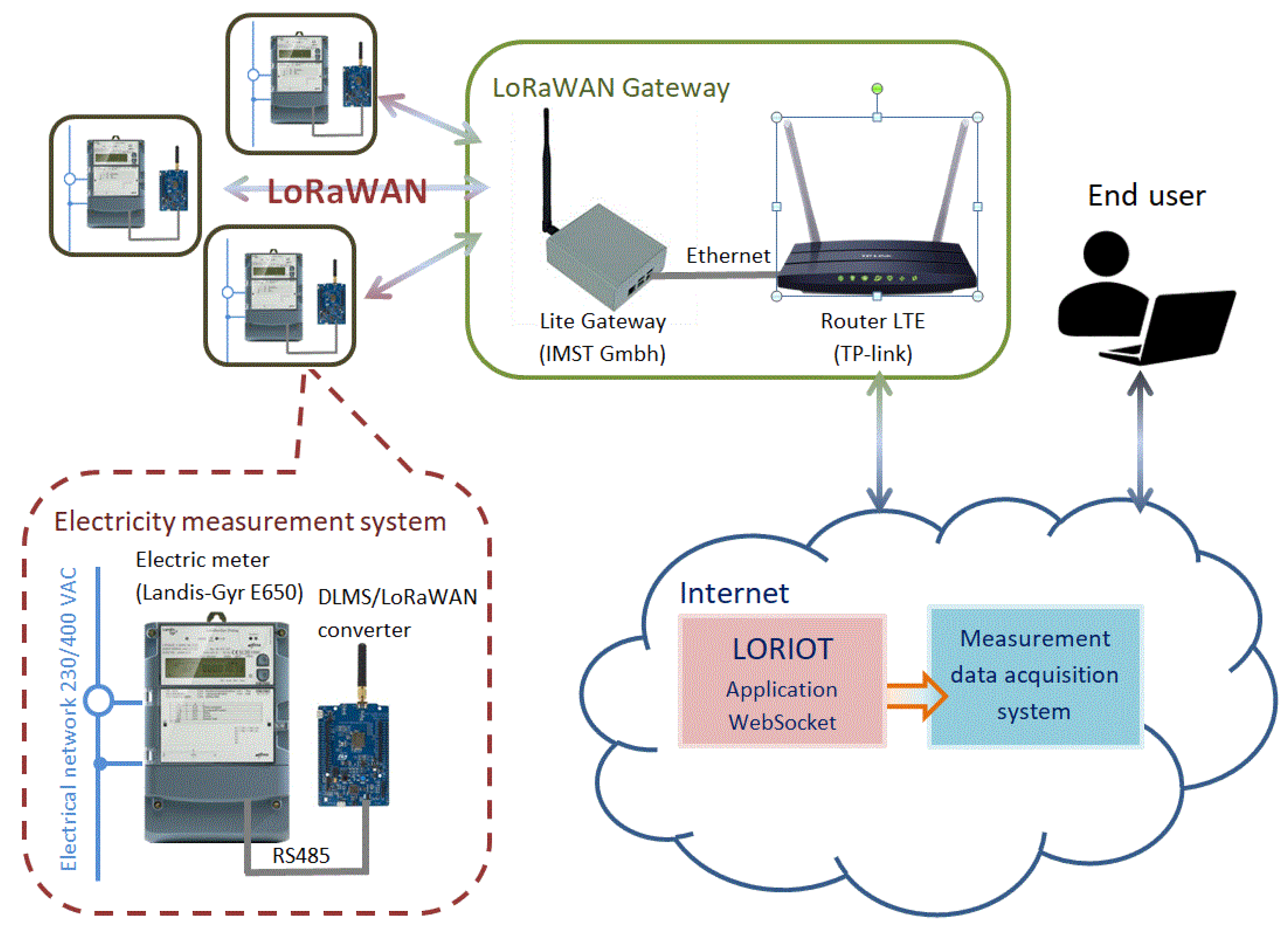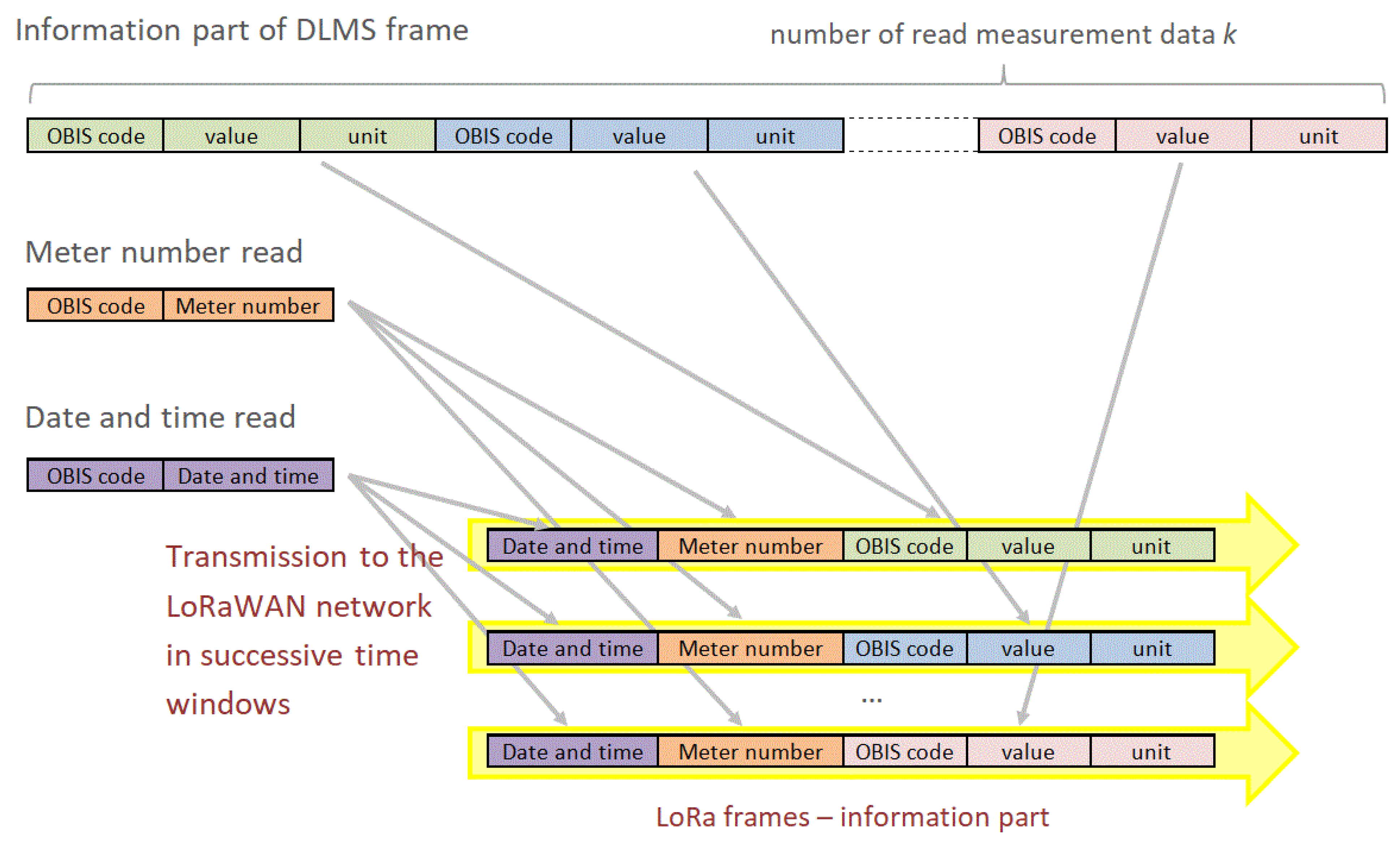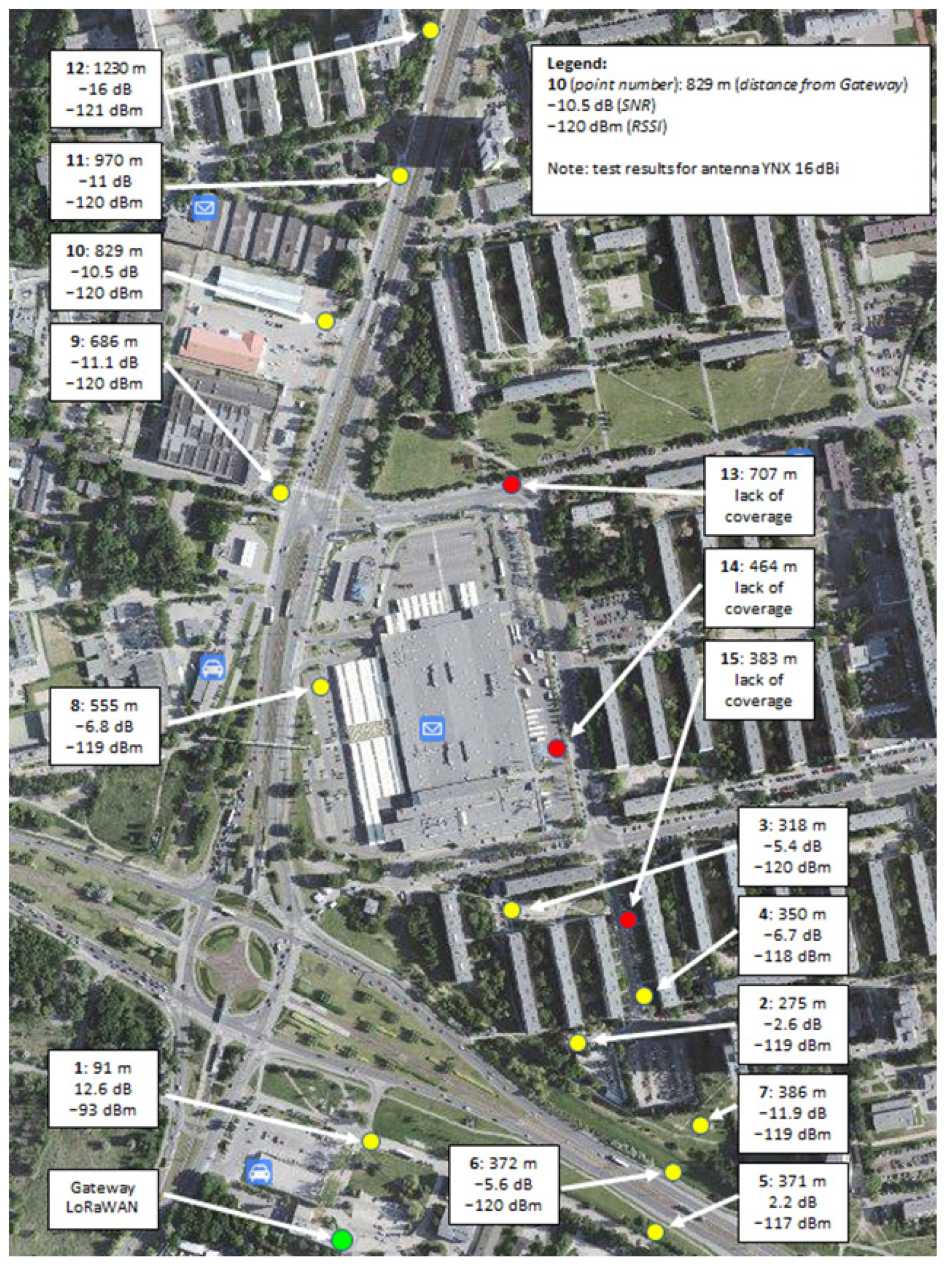LPWAN Networks for Energy Meters Reading and Monitoring Power Supply Network in Intelligent Buildings
Abstract
:1. Introduction
2. Intelligent Buildings
- electricity generation system equipment, such as a photovoltaic installation installed on the roof or façade of a building,
- energy storage devices such as electricity storage tanks with the possibility of returning it to the end user for consumption, and thermal energy storage devices in which electricity is converted into thermal energy stored in insulated water tanks for use as domestic hot water or heating water,
- electric car charging stations.
3. Long-Range Radio Networks LPWAN and the Internet of Things
- Quality of service—understood as reliability. In terms of mobile operator services, it is large but comes with a higher cost of service. In addition, the service is standard, so it is available throughout the country, for example. On the other hand, if reliability and transmission speed parameters are not a priority, it is possible to use a LoRaWAN network at a lower cost and achieve a comparable communication range.
- Battery life and sleep mode—parameters that affect how long the device works without servicing. For CIoT devices, the battery power consumption is higher but the response time of the end devices is shorter and the transmission speed is higher compared to LoRaWAN.
- Network coverage and range—in terms of devices and networks, the coverage for CIoT will be the same as for LTE (same base stations), however, it is required that the LTE network operator activates device support in the area. Private networks based on ISM bandwidth may have better coverage and range in rural areas, while in urban areas the performance is comparable. Both parameters depend on the output power, where for LTE it is 20 to 23 dBm or 100 to 200 mW, and for the 868 MHz band it is 14 dBm, which is 25 mW. Thus, despite being several times less powerful, these networks match the range and coverage of CIoT networks. This is their strong advantage when building a private independent long-range network.
- Location—depending on the intended use, the network can be based on existing mobile base stations, therefore the cost of launching a new service on existing infrastructure is not large. On the other hand, this can be a limitation compared to for example LoRaWAN technology, where the deployment of gateways in the field can be adapted to specific project requirements.
- Network cost—includes the cost of terminal equipment, base stations, gateways, commercial cloud application fees, LTE network subscriptions. Preparing completely private networks, for example LoRaWAN, also requires costs to build own layer of network servers and application servers.
4. The Proposed System
4.1. Hardware Layer—Electricity Meters
- a module for energy and power tariffs and an internal timer that controls the module’s operation,
- recording of load profiles for all types of energy—consecutive values of energy registers stored every 15 min,
- recording of total energy and for each phase,
- measuring of total active and reactive power and for each phase separately,
- measurements of network values such as voltages, currents, power factor, coefficient of higher harmonic content in voltages and currents, network frequency,
- recording of events affecting reliability of measurements, anti-theft functions,
- additional two-state outputs allowing to configure alarm signals,
- additional power supply unit that sustains operation of the meter in the event of shutdown of a particular receiver or measuring point,
- communication interfaces including both electrical connector standards (RS232, RS485) and communication protocol standards, the most commonly used of which is the protocol described by the IEC 62056 series of standards package, called DLMS (Device Language Message Specification) protocol.
- remotely controlled disconnector that allows to switch off individual consumers when their active power exceeds a certain level
- additional interface for communication with the Home Area Network (HAN)
- the possibility of sending from the metering system to the meter display text information intended for a given customer
- providing information on energy consumption in real time, which allows the recipient to make decisions about choosing the optimal tariff for the time of lower or higher energy consumption.
- the data exchange between the device and the reading system is based on the client/server model, where the meter acts as a server,
- the protocol is connection-oriented, where a communication session includes 3 phases: establishing a connection at the application level, exchanging packages and reading data, and terminating the connection session; the entire process must continue uninterrupted [29].
4.2. Communication Layer
- Features of the DLMS protocol prevent meters from being incorporated directly into the LoRaWAN without the need for additional intermediary devices. The network does not provide the connection continuity required by the DLMS, as due to ISM bandwidth occupancy limits of up to 1%, intervals between successive data frames are required. In fact, even at the highest predicted speeds, the interval between frames can be as long as 2 s [30].
- The LoRaWAN protocol for class A end devices primarily assumes unidirectional (uplink) communication, thus sending data from the device to the application server [31]. High channel capacity is not expected for the downlink direction. This feature makes it completely impossible to use the DLMS session connection mode, in which reading relies on the exchange of request-response frames.
- RS485 interface designed for local communication with the meter, supported by DLMS protocol driver implemented in the converter,
- USB port used for parameterization of the device and local monitoring of the read measurement data and for supplying the converter; when local monitoring is not necessary, the port is used only for connecting the power supply unit,
- LoRa radio interface with embedded LoRaWAN network protocol stack provided by ST Microelectronics in the form of internal software libraries for STM32L0—ARM Cortex M0+ microcontrollers.
4.3. Application Layer
5. Discussion
- The maximum range of network operation obtained during the tests (1230 m) was shorter than given in the catalog data of the gate manufacturer.
- The influence of the landform can be clearly seen—high buildings are obstacles for the radio signal (see points 13, 14, and 15).
- Increasing the height of the gateway antenna mounting significantly improves the quality of communication.
6. Conclusions
Author Contributions
Funding
Data Availability Statement
Acknowledgments
Conflicts of Interest
Abbreviations
| Acronym | Explanation |
| BMS | Building Management System |
| OMS | Object Management System |
| LPWAN | Low-Power Wide-Area Network |
| LoRaWAN | Long-Range Wide-Area Network |
| IoT | Internet of Things |
| CIoT | Cellular Internet of Things |
| NB-IoT | Narrowband Internet of Things |
| IIoT | Industrial Internet of Things |
| HVAC | Heating, Ventilation, Air Conditioning |
| PV | Photovoltaic |
| DLMS | Device Language Message Specification |
| PLC | Power Line Communication |
| GSM | Global System for Mobile Communications |
| GPRS | General Packet Radio Service |
| LTE | Long Term Evolution |
| Wi-Fi | Wireless Fidelity |
| Wi-SUN | Wireless Smart Utility Network |
| BPSK | Binary Phase Shift-Keying |
| DBPSK | Differential Binary Phase Shift-Keying |
| QPSK | Quadrature Phase Shift Keying |
| FSK | Frequency-Shift Keying |
| GFSK | Gaussian Frequency-Shift Keying |
| QAM | Quadrature Amplitude Modulation |
| CSS | Chirp Spread Spectrum |
| HAN | Home Area Network |
| OBIS | Object Identification System |
| AI | Artificial Intelligence |
| ISM | Industrial, Scientific, Medical |
| ETSI | European Telecommunications Standards Institute |
References
- Tang, S.; Shelden, D.R.; Eastman, C.H.M.; Pishdad-Bozorgi, P.; Gao, X. BIM assisted Building Automation System information exchange using BACnet and IFC. Autom. Constr. 2020, 110, 1–14. [Google Scholar] [CrossRef]
- Harish, V.S.K.V.; Kumar, A. A review on modeling and simulation of building energy systems. Renew. Sustain. Energy Rev. 2015, 56, 1272–1292. [Google Scholar] [CrossRef]
- Peruzzi, G.; Pozzebon, A. A Review of Energy Harvesting Techniques for Low Power Wide Area Networks (LPWANs). Energies 2020, 13, 3433. [Google Scholar] [CrossRef]
- LoRa Alliance Website, LoRa Technology. Available online: https://lora-alliance.org/about-lorawan (accessed on 4 November 2021).
- Haxhibeqiri, J.; De Poorter, E.; Moerman, I.; Hoebeke, J. A survey of LoRaWAN for IoT: From technology to application. Sensors 2018, 18, 3995. [Google Scholar] [CrossRef] [Green Version]
- Magrin, D.; Capuzzo, M.; Zanella, A. A thorough study of LoRaWAN performance under different parameter settings. IEEE Internet Things J. 2019, 7, 116–127. [Google Scholar] [CrossRef] [Green Version]
- Finnegan, J.; Farrell, R.; Brown, S. Analysis and Enhancement of the LoRaWAN Adaptive Data Rate Scheme. IEEE Internet Things J. 2020, 7, 7171–7180. [Google Scholar] [CrossRef]
- Farhad, A.; Kim, D.H.; Subedi, S.; Pyun, J.Y. Enhanced LoRaWAN Adaptive Data Rate for Mobile Internet of Things Devices. Sensors 2020, 20, 6466. [Google Scholar] [CrossRef]
- Farhad, A.; Kim, D.H.; Kim, B.H.; Mohammed, A.F.Y.; Pyun, J.Y. Mobility-Aware Resource Assignment to IoT Applications in Long-Range Wide Area Networks. IEEE Access 2020, 8, 186111–186124. [Google Scholar] [CrossRef]
- Farhad, A.; Kim, D.H.; Pyun, J.Y. Resource Allocation to Massive Internet of Things in LoRaWANs. Sensors 2020, 20, 2645. [Google Scholar] [CrossRef] [PubMed]
- Al-Gumaei, Y.A.; Aslam, N.; Chen, X.; Raza, M.; Ansari, R.I. Optimising Power Allocation in LoRaWAN IoT Applications. IEEE Internet Things J. 2021. [Google Scholar] [CrossRef]
- Gleonec, P.D.; Ardouin, J.; Gautier, M.; Berder, O. Energy Allocation for LoRaWAN Nodes with Multi-Source Energy Harvesting. Sensors 2021, 21, 2874. [Google Scholar] [CrossRef]
- Khalifeh, A.; Aldahdouh, K.; Alouneh, S. LoRaWAN Energy Optimization with Security Consideration. Int. Arab. J. Inf. Technol. 2021, 18, 476–483. [Google Scholar] [CrossRef]
- Mai, D.L.; Kim, M.K. Multi-Hop LoRa Network Protocol with Minimized Latency. Energies 2020, 13, 1368. [Google Scholar] [CrossRef] [Green Version]
- Sharma, V.; You, I.; Pau, G.; Collotta, M.; Lim, J.D.; Kim, J.N. LoRaWAN-Based Energy-Efficient Surveillance by Drones for Intelligent Transportation Systems. Energies 2018, 11, 573. [Google Scholar] [CrossRef] [Green Version]
- Rinaldi, S.; Pasetti, M.; Sisinni, E.; Bonafini, F.; Ferrari, P.; Rizzi, M.; Flammini, A. On the Mobile Communication Requirements for the Demand-Side Management of Electric Vehicles. Energies 2018, 11, 1220. [Google Scholar] [CrossRef] [Green Version]
- Bäumker, E.; Conrad, L.; Comella, L.M.; Woias, P. A Fully Featured Thermal Energy Harvesting Tracker for Wildlife. Energies 2021, 14, 6363. [Google Scholar] [CrossRef]
- Cappelli, I.; Parrino, S.; Pozzebon, A.; Salta, A. Providing Energy Self-Sufficiency to LoRaWAN Nodes by Means of Thermoelectric Generators (TEGs)-Based Energy Harvesting. Energies 2021, 14, 7322. [Google Scholar] [CrossRef]
- Bhatt, J.; Verma, H.K. Design and Development of Wired Building Automation Systems. Energy Build. 2015, 103, 396–413. [Google Scholar] [CrossRef]
- Dospinescu, O.; Perca, M. Technological integration for increasing the contextual level of information. Analele Ştiinţifice Universităţii Alexandru Ioan Cuza Iaşi. Ştiinţe Economice 2011, 58, 571–581. [Google Scholar]
- Jia, C.; Ding, H.; Zhang, C.; Zhang, X. Design of a dynamic key management plan for intelligent building energy management system based on wireless sensor network and blockchain technology. Alex. Eng. J. 2021, 60, 337–346. [Google Scholar] [CrossRef]
- He, Y.; Du, Y.; Guo, H.; Yang, J.; Sun, Y.; Wang, Z.; Li, C.; Sun, K.; Zhang, M.; Shi, C.; et al. Design and Research of Intelligent Building Control System. In Proceedings of the IOP Conference Series: Earth and Environmental Science, Kamakura City, Japan, 10–11 October 2021; Volume 632, p. 042023. [Google Scholar]
- Prusak, D.; Karpiel, G.; Kułakowski, K. The Architecture of a Real-Time Control System for Heating Energy Management in the Intelligent Building. Energies 2021, 14, 5402. [Google Scholar] [CrossRef]
- Dospinescu, O.; Dospinescu, N. A profitability regression model of Romanian stock exchange’s energy companies. In Proceedings of the 17th International Conference on Informatics in Economy Education, Research & Business Technologies, Iasi, Romania, 17–20 May 2018; pp. 169–174. Available online: https://www.researchgate.net/publication/325847421 (accessed on 12 November 2021).
- Antonowicz, A.; Derbis, P.; Nowak, M.; Urbaniak, A. Smart Meter in Voltage Control System of Power Network. In Proceedings of the 21th International Carpathian Control Conference (ICCC), High Tatras, Slovakia, 27–29 October 2020; pp. 1–6. [Google Scholar] [CrossRef]
- Harada, H.; Mizutani, K.; Fujiwara, J.; Mochizuki, K.; Obata, K.; Okumura, R. IEEE 802.15.4g Based Wi-SUN Communication Systems. IEICE Trans. Commun. 2017, E100-B, 1032–1043. [Google Scholar] [CrossRef] [Green Version]
- Sinha, S.R.; Wei, Y.; Hwang, S. A survey on LPWA technology: LoRa and NB-IoT. ICT Express 2017, 3, 14–21. [Google Scholar] [CrossRef]
- Electricity Meter IEC/MID, Industrial and Commercial, ZMD300AT/CT E650 Series 3, User Manual. Available online: https://www.landisgyr.eu/webfoo/wp-content/uploads/2012/09/D000030108-E650-ZMD300xT-Series-3-User-Manual-en-k.pdf (accessed on 4 November 2021).
- DLMS User Association. Green Book Edition 9, Excerpt from Companion Specification for Energy Metering, DLMS/COSEM Architecture and Protocols. 8 May 2019. Available online: https://www.dlms.com/files/Green_Book_Edition_9-Excerpt.pdf (accessed on 4 November 2021).
- Adelantado, F.; Vilajosana, X.; Tuset-Peiro, P.; Martinez, B.; Melià-Seguí, J.; Watteyne, T. Understanding the Limits of LoRaWAN. IEEE Commun. Mag. 2017, 55, 34–40. [Google Scholar] [CrossRef] [Green Version]
- LoRa Alliance Technical Committee. LoRaWAN™ 1.1 Specification, Version 1.1, LoRa Alliance. Available online: https://lora-alliance.org/wp-content/uploads/2020/11/lorawantm_specification_-v1.1.pdf (accessed on 4 November 2021).
- Dospinescu, O.; Perca, M. Web Services in Mobile Applications. Informatica Economică 2013, 17, 17–26. [Google Scholar] [CrossRef]
- Watanabe, T.; Shioji, E.; Akiyama, M.; Mori, T. Melting Pot of Origins: Compromising the Intermediary Web Services that Rehost Websites. In Proceedings of the Network and Distributed Systems Security (NDSS) Symposium 2020, San Diego, CA, USA, 23–26 February 2020. [Google Scholar] [CrossRef]
- Daaji, M.; Ouni, A.; Gammoudi, M.M.; Bouktif, S.; Mkaouer, M.W. Multi-criteria Web Services Selection: Balancing the Quality of Design and Quality of Service. ACM Trans. Internet Technol. 2022, 22, 1–31. [Google Scholar] [CrossRef]
- Semtech White Paper, Real-World LoRaWAN™ Network Capacity for Electrical Metering Aplications, Semtech Corporation. Available online: https://info.semtech.com/network_capacity_white_paper_download (accessed on 4 November 2021).



| Technology | Sigfox | LoRaWAN | NB-IoT, 3GPP | Wi-SUN IEEE 802.15.4g | LTE Cat M1 | |
|---|---|---|---|---|---|---|
| Parameters | ||||||
| Frequency | 863–870 MHz (868,0–868,2 MHz) | 863–870 MHz (867.0–868.6 MHz) | GSM 900 MHz, LTE 800 MHz, Standalone GSM LTE—In-Band LTE—Guard Band | 863–870 MHz | LTE 800 MHz | |
| No of channels/channel width | 2000/100 Hz | 8/125 kHz (250, 500 kHz) | DL: 12/15 kHz (OFDM) UL:12/15 kHz (SC-FDMA) | 35/200 kHz, | 6/180 kHz | |
| Modulation | DBPSK | CSS, GFSK | BPSK, QPSK | FSK, GFSK | BPSK, QPSK, 16QAM | |
| Bandwidth | UL: 100 bps DL: 600 bps Max. payload 12 bytes, 140 packets/day | 0.3–11 kbps <50 kbps (FSK) | 20–250 kbps | 50–300 kbps | <1 Mbps | |
| Output power | 14 dBm | 14 dBm | 20/23 dBm | 14 dBm | 20/23 dBm | |
| Network type | private SIGFOX, star configuration | private, star or mesh configuration | cell network LTE | private, mesh configuration | cell network LTE | |
| Range: city/country | 9/40 km | 5/15 km | 2/35 km | 2/5 km | - | |
| Battery life | 20 years | 10 years | 10 years | being tested | 5–10 years | |
Publisher’s Note: MDPI stays neutral with regard to jurisdictional claims in published maps and institutional affiliations. |
© 2021 by the authors. Licensee MDPI, Basel, Switzerland. This article is an open access article distributed under the terms and conditions of the Creative Commons Attribution (CC BY) license (https://creativecommons.org/licenses/by/4.0/).
Share and Cite
Nowak, M.; Derbis, P.; Kurowski, K.; Różycki, R.; Waligóra, G. LPWAN Networks for Energy Meters Reading and Monitoring Power Supply Network in Intelligent Buildings. Energies 2021, 14, 7924. https://doi.org/10.3390/en14237924
Nowak M, Derbis P, Kurowski K, Różycki R, Waligóra G. LPWAN Networks for Energy Meters Reading and Monitoring Power Supply Network in Intelligent Buildings. Energies. 2021; 14(23):7924. https://doi.org/10.3390/en14237924
Chicago/Turabian StyleNowak, Mariusz, Piotr Derbis, Krzysztof Kurowski, Rafał Różycki, and Grzegorz Waligóra. 2021. "LPWAN Networks for Energy Meters Reading and Monitoring Power Supply Network in Intelligent Buildings" Energies 14, no. 23: 7924. https://doi.org/10.3390/en14237924
APA StyleNowak, M., Derbis, P., Kurowski, K., Różycki, R., & Waligóra, G. (2021). LPWAN Networks for Energy Meters Reading and Monitoring Power Supply Network in Intelligent Buildings. Energies, 14(23), 7924. https://doi.org/10.3390/en14237924






